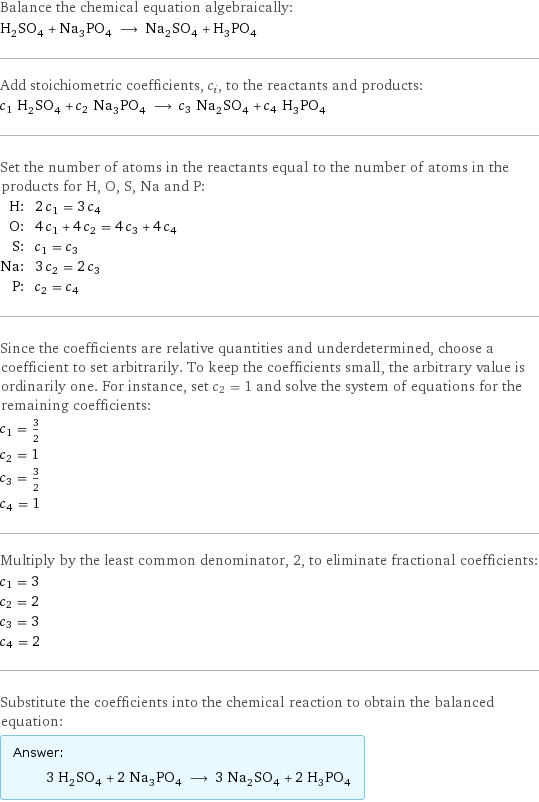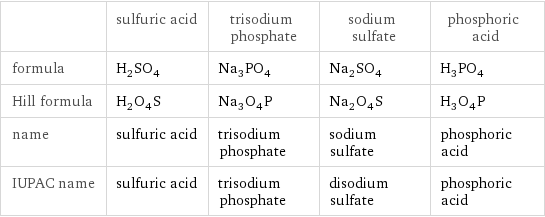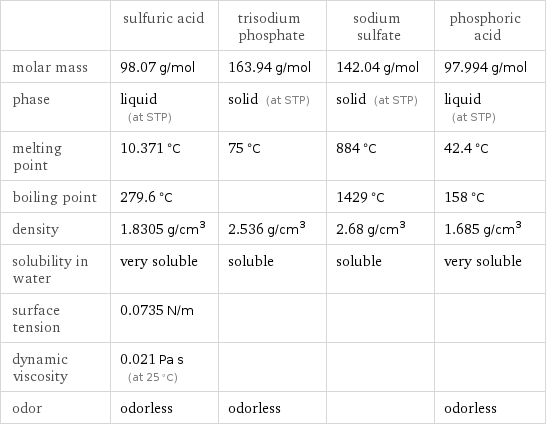Input interpretation

H_2SO_4 sulfuric acid + Na_3PO_4 trisodium phosphate ⟶ Na_2SO_4 sodium sulfate + H_3PO_4 phosphoric acid
Balanced equation

Balance the chemical equation algebraically: H_2SO_4 + Na_3PO_4 ⟶ Na_2SO_4 + H_3PO_4 Add stoichiometric coefficients, c_i, to the reactants and products: c_1 H_2SO_4 + c_2 Na_3PO_4 ⟶ c_3 Na_2SO_4 + c_4 H_3PO_4 Set the number of atoms in the reactants equal to the number of atoms in the products for H, O, S, Na and P: H: | 2 c_1 = 3 c_4 O: | 4 c_1 + 4 c_2 = 4 c_3 + 4 c_4 S: | c_1 = c_3 Na: | 3 c_2 = 2 c_3 P: | c_2 = c_4 Since the coefficients are relative quantities and underdetermined, choose a coefficient to set arbitrarily. To keep the coefficients small, the arbitrary value is ordinarily one. For instance, set c_2 = 1 and solve the system of equations for the remaining coefficients: c_1 = 3/2 c_2 = 1 c_3 = 3/2 c_4 = 1 Multiply by the least common denominator, 2, to eliminate fractional coefficients: c_1 = 3 c_2 = 2 c_3 = 3 c_4 = 2 Substitute the coefficients into the chemical reaction to obtain the balanced equation: Answer: | | 3 H_2SO_4 + 2 Na_3PO_4 ⟶ 3 Na_2SO_4 + 2 H_3PO_4
Structures

+ ⟶ +
Names

sulfuric acid + trisodium phosphate ⟶ sodium sulfate + phosphoric acid
Equilibrium constant
![Construct the equilibrium constant, K, expression for: H_2SO_4 + Na_3PO_4 ⟶ Na_2SO_4 + H_3PO_4 Plan: • Balance the chemical equation. • Determine the stoichiometric numbers. • Assemble the activity expression for each chemical species. • Use the activity expressions to build the equilibrium constant expression. Write the balanced chemical equation: 3 H_2SO_4 + 2 Na_3PO_4 ⟶ 3 Na_2SO_4 + 2 H_3PO_4 Assign stoichiometric numbers, ν_i, using the stoichiometric coefficients, c_i, from the balanced chemical equation in the following manner: ν_i = -c_i for reactants and ν_i = c_i for products: chemical species | c_i | ν_i H_2SO_4 | 3 | -3 Na_3PO_4 | 2 | -2 Na_2SO_4 | 3 | 3 H_3PO_4 | 2 | 2 Assemble the activity expressions accounting for the state of matter and ν_i: chemical species | c_i | ν_i | activity expression H_2SO_4 | 3 | -3 | ([H2SO4])^(-3) Na_3PO_4 | 2 | -2 | ([Na3PO4])^(-2) Na_2SO_4 | 3 | 3 | ([Na2SO4])^3 H_3PO_4 | 2 | 2 | ([H3PO4])^2 The equilibrium constant symbol in the concentration basis is: K_c Mulitply the activity expressions to arrive at the K_c expression: Answer: | | K_c = ([H2SO4])^(-3) ([Na3PO4])^(-2) ([Na2SO4])^3 ([H3PO4])^2 = (([Na2SO4])^3 ([H3PO4])^2)/(([H2SO4])^3 ([Na3PO4])^2)](../image_source/cca47e572cf0b69da80cca94961ad7cf.png)
Construct the equilibrium constant, K, expression for: H_2SO_4 + Na_3PO_4 ⟶ Na_2SO_4 + H_3PO_4 Plan: • Balance the chemical equation. • Determine the stoichiometric numbers. • Assemble the activity expression for each chemical species. • Use the activity expressions to build the equilibrium constant expression. Write the balanced chemical equation: 3 H_2SO_4 + 2 Na_3PO_4 ⟶ 3 Na_2SO_4 + 2 H_3PO_4 Assign stoichiometric numbers, ν_i, using the stoichiometric coefficients, c_i, from the balanced chemical equation in the following manner: ν_i = -c_i for reactants and ν_i = c_i for products: chemical species | c_i | ν_i H_2SO_4 | 3 | -3 Na_3PO_4 | 2 | -2 Na_2SO_4 | 3 | 3 H_3PO_4 | 2 | 2 Assemble the activity expressions accounting for the state of matter and ν_i: chemical species | c_i | ν_i | activity expression H_2SO_4 | 3 | -3 | ([H2SO4])^(-3) Na_3PO_4 | 2 | -2 | ([Na3PO4])^(-2) Na_2SO_4 | 3 | 3 | ([Na2SO4])^3 H_3PO_4 | 2 | 2 | ([H3PO4])^2 The equilibrium constant symbol in the concentration basis is: K_c Mulitply the activity expressions to arrive at the K_c expression: Answer: | | K_c = ([H2SO4])^(-3) ([Na3PO4])^(-2) ([Na2SO4])^3 ([H3PO4])^2 = (([Na2SO4])^3 ([H3PO4])^2)/(([H2SO4])^3 ([Na3PO4])^2)
Rate of reaction
![Construct the rate of reaction expression for: H_2SO_4 + Na_3PO_4 ⟶ Na_2SO_4 + H_3PO_4 Plan: • Balance the chemical equation. • Determine the stoichiometric numbers. • Assemble the rate term for each chemical species. • Write the rate of reaction expression. Write the balanced chemical equation: 3 H_2SO_4 + 2 Na_3PO_4 ⟶ 3 Na_2SO_4 + 2 H_3PO_4 Assign stoichiometric numbers, ν_i, using the stoichiometric coefficients, c_i, from the balanced chemical equation in the following manner: ν_i = -c_i for reactants and ν_i = c_i for products: chemical species | c_i | ν_i H_2SO_4 | 3 | -3 Na_3PO_4 | 2 | -2 Na_2SO_4 | 3 | 3 H_3PO_4 | 2 | 2 The rate term for each chemical species, B_i, is 1/ν_i(Δ[B_i])/(Δt) where [B_i] is the amount concentration and t is time: chemical species | c_i | ν_i | rate term H_2SO_4 | 3 | -3 | -1/3 (Δ[H2SO4])/(Δt) Na_3PO_4 | 2 | -2 | -1/2 (Δ[Na3PO4])/(Δt) Na_2SO_4 | 3 | 3 | 1/3 (Δ[Na2SO4])/(Δt) H_3PO_4 | 2 | 2 | 1/2 (Δ[H3PO4])/(Δt) (for infinitesimal rate of change, replace Δ with d) Set the rate terms equal to each other to arrive at the rate expression: Answer: | | rate = -1/3 (Δ[H2SO4])/(Δt) = -1/2 (Δ[Na3PO4])/(Δt) = 1/3 (Δ[Na2SO4])/(Δt) = 1/2 (Δ[H3PO4])/(Δt) (assuming constant volume and no accumulation of intermediates or side products)](../image_source/0666e63c1443f79245979724a7600906.png)
Construct the rate of reaction expression for: H_2SO_4 + Na_3PO_4 ⟶ Na_2SO_4 + H_3PO_4 Plan: • Balance the chemical equation. • Determine the stoichiometric numbers. • Assemble the rate term for each chemical species. • Write the rate of reaction expression. Write the balanced chemical equation: 3 H_2SO_4 + 2 Na_3PO_4 ⟶ 3 Na_2SO_4 + 2 H_3PO_4 Assign stoichiometric numbers, ν_i, using the stoichiometric coefficients, c_i, from the balanced chemical equation in the following manner: ν_i = -c_i for reactants and ν_i = c_i for products: chemical species | c_i | ν_i H_2SO_4 | 3 | -3 Na_3PO_4 | 2 | -2 Na_2SO_4 | 3 | 3 H_3PO_4 | 2 | 2 The rate term for each chemical species, B_i, is 1/ν_i(Δ[B_i])/(Δt) where [B_i] is the amount concentration and t is time: chemical species | c_i | ν_i | rate term H_2SO_4 | 3 | -3 | -1/3 (Δ[H2SO4])/(Δt) Na_3PO_4 | 2 | -2 | -1/2 (Δ[Na3PO4])/(Δt) Na_2SO_4 | 3 | 3 | 1/3 (Δ[Na2SO4])/(Δt) H_3PO_4 | 2 | 2 | 1/2 (Δ[H3PO4])/(Δt) (for infinitesimal rate of change, replace Δ with d) Set the rate terms equal to each other to arrive at the rate expression: Answer: | | rate = -1/3 (Δ[H2SO4])/(Δt) = -1/2 (Δ[Na3PO4])/(Δt) = 1/3 (Δ[Na2SO4])/(Δt) = 1/2 (Δ[H3PO4])/(Δt) (assuming constant volume and no accumulation of intermediates or side products)
Chemical names and formulas

| sulfuric acid | trisodium phosphate | sodium sulfate | phosphoric acid formula | H_2SO_4 | Na_3PO_4 | Na_2SO_4 | H_3PO_4 Hill formula | H_2O_4S | Na_3O_4P | Na_2O_4S | H_3O_4P name | sulfuric acid | trisodium phosphate | sodium sulfate | phosphoric acid IUPAC name | sulfuric acid | trisodium phosphate | disodium sulfate | phosphoric acid
Substance properties

| sulfuric acid | trisodium phosphate | sodium sulfate | phosphoric acid molar mass | 98.07 g/mol | 163.94 g/mol | 142.04 g/mol | 97.994 g/mol phase | liquid (at STP) | solid (at STP) | solid (at STP) | liquid (at STP) melting point | 10.371 °C | 75 °C | 884 °C | 42.4 °C boiling point | 279.6 °C | | 1429 °C | 158 °C density | 1.8305 g/cm^3 | 2.536 g/cm^3 | 2.68 g/cm^3 | 1.685 g/cm^3 solubility in water | very soluble | soluble | soluble | very soluble surface tension | 0.0735 N/m | | | dynamic viscosity | 0.021 Pa s (at 25 °C) | | | odor | odorless | odorless | | odorless
Units
